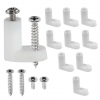That is not how it works.
U = R*I
With R set (the fixture) and I limited (by the supply) U is just the product of the two.
Please learn some basic electronics before you go to other people and explain the world to them.
Do you really think that this is how you apply Ohms law in this case? Yes, i know it, its not even high school level, here we learn it when were 14.
So you mean if you run a 42V CONSTANT VOLTAGE driver at half its rated current it becomes a 84V driver? Good luck. Im not engaging in this with you anymore. Give the reason why OP should run it with voltage dim on max voltage dim or go home. Youve not addressed the issue raised with the advice in your reply.
Thanks for the reply Lou. Just wanted to check that I'm following what you're saying - this means that the resistance of the fixture will be constant(ish - varying with the temperature of the strips), and the driver (assuming it's constant current) will provide, well, constant current, therefore the voltage that the fixture sees will be determined by those factors, rather than the driver itself, right?
I haven't had time to get through the whole playlist that Medicinal linked yet (busy times here, bloody typical!), but I'm hoping between this thread and that tutorial, I'll finally have a proper grasp on how this all works. Fingers crossed!
The driver in question is constant voltage driver with constant current region between 21V to 42V. You can check up on this with meanwell. It works exactly like Lou and you explain in this region. Above 42V it works as a constant voltage driver. It will output around 46V on max voltage dim as per the report sheet on the meanwell website:
https://www.meanwell-web.com/content/files/pdfs/productPdfs/MW/HLG-320H/HLG-320H-42-rpt.pdf
And this voltage is constant and set by the driver no matter what output current you set it to.
Turning voltage up to max wouldnt really affect your build but it would be running the driver at a higher power level; youd have higher power consumption for no good reason, your running the driver with a 5V extra (the required voltage is about 41V for 2 strings in series) which means higher power consumption.
What i explained earlier on is a safety feature of this type of driver which protects your build: it limits the output voltage to just above the required voltage necessary for the drive current of each string at the drivers max current output. It means that in the case you lost some strings the light will continue drawing the same amount of current per string instead of the remaining strings drawing more current per string. If you have a bit of extra over voltage then each string will draw more current, effectively sharing the current over less strings> higher current per string.
Its not really a big deal, those strips have a fairly high max current so its not super necessary. If you dont want to bother about trying to figure out who of us two is correct you can just leave the voltage dim where it is, it will work fine. But turning it up to higher voltage will increase your power consumption, remove the safety feature and give you zero benefit.
It may be that my explanation is hard to understand. Here
@Prawn Connery is talking about the same thing, maybe it makes more sense:
my first LED grow was with 50 odd COBs, I remember those hated undervoltage... had to leave drivers set to max, and use current for dimming. I should explain that we do use the voltage limit function on our bigger builds because we have two 5A LED panels wired in parallel connected to a 480W...
www.rollitup.org
I dont really care what you do, but its shitty if you get bad advice due to someone harassing my replies. Lou is close enough to right to not be able to understand that hes wrong unfortunately.


